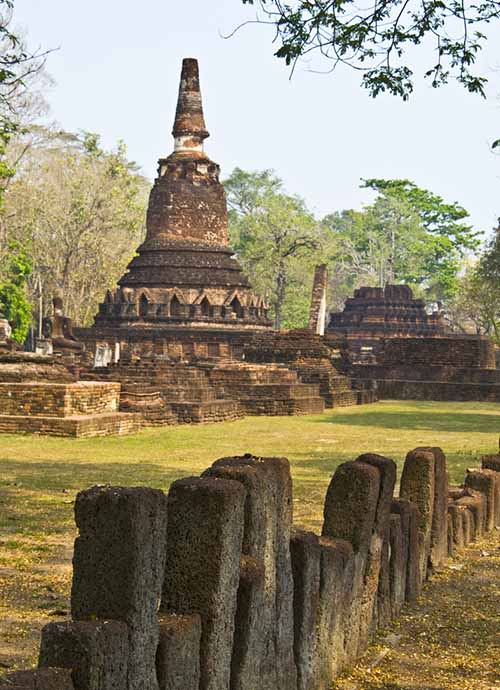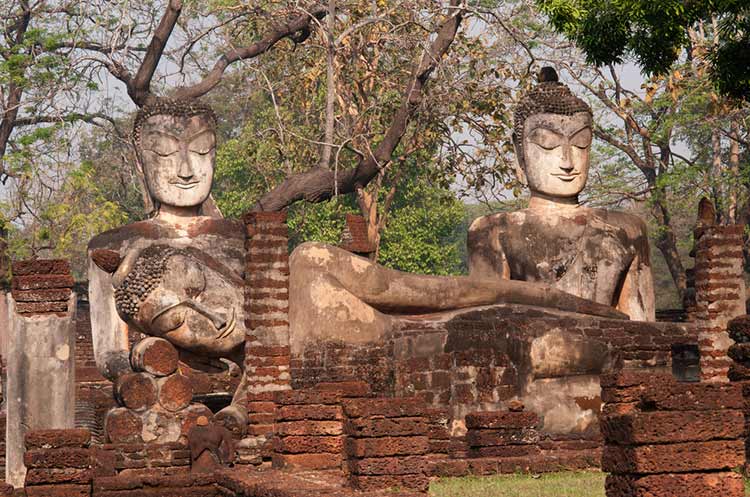
Temples
In Kamphaeng Phet Historical Park
Kamphaeng Phet Historical Park contains the ruins of dozens of temples in various states of preservation built in the ancient town of Kamphaeng Phet. Some temples have been partially restored, while of others little more than a pile of laterite blocks remain.
The town played an important role in both the Sukhothai and Ayutthaya empires from the 13th until the 17th century.
Architectural styles
Its architecture was mainly influenced by Singhalese, Sukhothai and Ayutthaya styles. Examples of Sukhothai style are the elephant encircled chedi and the Phra Attharot standing Buddha image of the Wat Phra Kaew and the mondop enshrining Buddha images in four postures of the Wat Phra Si Iriyabot.
Zones of Kamphaeng Phet Historical Park
The ruins of Kamphaeng Phet are spread out across three zones.
Central zone
The central zone, the walled center of the old town, contained the most important temples as well as the Royal Palace, the Sa Mon. The temples of the central zone only have a Buddhavasa area where all structures are dedicated to the veneration of the Buddha. As there were no resident monks at these temples, there was no Sanghavasa area.
North zone
The temples of the north zone are forest temples in a hilly area known as Aranyik. These temple comprise of both a Buddhavasa area and a Sanghavasa area. Many Aranyik temples have a well and bathing area in front of the temple, a feature copied from Singhalese temples.
West zone
The West Zone, Muang Nakhon Chum is found on the West bank of the Ping river. The area was settled during the 11th century. It is protected by a 2 to 3 meter high earthen wall. The zone measuring 400 meters x 2,900 meters contains 12 ancient monuments, mostly small, brick temples.
One of the few surviving temples in the walled area of the West zone is Wat Phra That Borommathat. Its chedi is believed to be the one mentioned in an ancient stone inscription which says that King Phra Maha Dharmaraja Li Thai founded a chedi in Muang Nakhon Chum in the year 1357. The chedi was likely a lotus bud shape in Sukhothai style. It was rebuilt in Burmese style by a Burmese trader towards the end of the 19th century.
The West zone also contains the recently restored Pom Thung Setthi fortress. The fortress built during the Ayutthaya era is surrounded by 6 meter high laterite walls, 85 meters long on each side.

Kamphaeng Phet Historical Park
Kamphaeng Phet style temples
The majority of temples in the Kamphaeng Phet Historical Park was built during the 15th and 16th centuries. Most monuments were constructed of large laterite blocks dug out from local quarries. The park’s laterite Buddha images covered with stucco have heavily corroded, their features largely worn away.
The typical Kamphaeng Phet temple is enclosed by a wall of laterite blocks and comprises of a principal chedi with the main viharn in front of it, a smaller ubosot and a number of subordinate chedis. The viharn was usually much larger than the ubosot, as the ubosot was used by monks only. The ubosot, the hall were monks get ordained, was enclosed by eight sema stones, boundary stones that mark the building’s sacred area.
All temples and shrines are dedicated to the veneration of the Buddha, the only exception being the Shiva shrine in the central zone.
Kamphaeng Phet style chedi
The most important structure of the temple was the principal chedi. Most chedis in the Kamphaeng Phet Historical Park are bell shaped chedis, usually standing on a square base and a number of receding octagonal tiers. The bell was topped with a tapering finial. The brick or laterite chedis were covered with stucco, of which little remains today. The lower part of the bell was adorned with sculpted lotus petals, still visible on the principal chedi of the Wat Phra That in the central zone.
Many “elephant encircled chedis” were built during the Sukhothai era. Protruding out of the square base were bodies of elephants that seemed to carry the chedi on their backs. An example of this type is one of the chedis of the Wat Phra Kaew in the central zone. Sometimes a mondop served as the principal chedi, like those of the Wat Phra Si Iriyabot and the Wat Mondop.
Kamphaeng Phet style viharn
The main viharn, the assembly hall, stood in front of the principal chedi. Laterite pillars would support the wooden roof that was covered with tiles. Rectangular holes in pillars and walls indicated the spot where wooden beams were fitted. In many of the forest temples of the North zone (Aranyik) the viharn stood on a large elevated base with balusters, designed to allow devotees to walk on the base around the viharn in a clockwise direction.
Temples in the Kamphaeng Phet Historical Park
Some of the temples are:
- Wat Phra That
- Wat Phra Kaew
- Wat Avasa Yai
- Wat Singha
- Wat Chang Rop
- Wat Phra Non
- Wat Phra Si Iriyabot